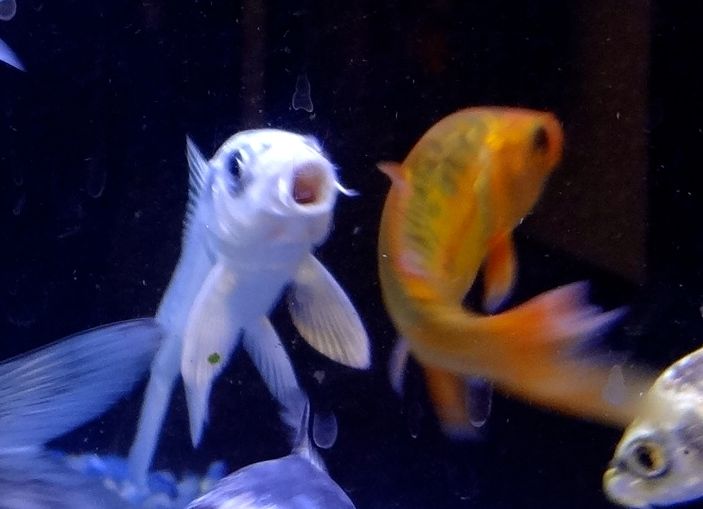
Spring Pond Care: Clean the MUCK out TODAY!
March 11, 2015

A customer called today and was worried about her pond. She bought some shubunkin goldfish at our last Two-fer Tuesday Freshwater Fish Sale and added them to her pond. Everything seemed fine, but last weekend she lost one of her big koi. She was wondering if the fish she got from us “did something” to her pond. (They did – but more on that in a minute.) She brought a sample of her pond water to be tested and we told her to do a big water change. We didn’t go far enough though, and I wanted to talk about SPRING POND CARE.
Last fall leaves and debris dropped into your pond, as is nature’s way. This was not a big deal because over the colder days of winter it just sat there, not bothering anyone. Now that the days are warming up, these leaves and debris are starting to break down and will really wreak havoc with the water quality of your pond. In fact, you may even see some foam on top, as our customer did. (Think of foam at the beach when the waves crash on shore – that’s nature’s way of ridding the water of harmful organics. In your pond, it has nowhere to go, so it just floats on top.) Also, as we have some warmer days, the fish in your pond are starting to move more, eating more, pooping more, and looking to spawn. Add a few NEW fish to this scenario and the bio-load can be deadly.
I urge you all to get out there as soon as humanly possible and CLEAN the muck out of your pond. Physically remove it with a net. Churn up the water and do a big water change to remove the particles floating around. Be sure to add water conditioner to remove the chlorine when you fill the pond back up.
READ ON FOR MORE INFORMATION
from our Spring Pond Care Guide
Time for a thorough “spring cleaning”
If your pond has leaves and other debris at the bottom from the winter – roll up your sleeves! Nearly draining the pond and physically removing the debris is crucial. Once the days start getting warmer and the water begins to heat up, the debris starts to rot in the pond your fish will be highly stressed by the toxic mess.
Add pond salt
Refill the pond with dechlorinated water and add pond salt. (Pond salt stimulates the slime coat of your fish, which helps protect them from bacterial infections, adds essential electrolytes, and improves gill function.)
Ponds with plants: Add 1 ¼ cupful of pond salt for each 100 gallons of pond water.
Ponds without plants: Add 2 ½ cupful of Pond Salt for each 100 gallons of pond water.
Do not use table salt! Table salt has iodine and other additives – it can kill your fish! Distribute the pond salt evenly around the perimeter of the pond
Before you do anything – you must calculate the volume of your pond. (how many gallons) Here’s how: multiply the length x width x depth of the pond IN INCHES. Divide by 231 and you’ll have how many GALLONS in your pond.
Test the Water
Regularly test the water in your pond so that you can address problems before they injure livestock or damage plants. Use a test kit made specifically for ponds to test for nitrate, nitrite, hardness, alkalinity, and pH. Better yet – bring a sample of your water to B&B Pet Stop – we’d be delighted to test the water for FREE.
Begin feeding again
As soon as the water temperature rises above 50 degrees Fahrenheit it is safe to offer food to your fish. Change to growth or color formulas and put the wheat germ or low protein formulas winter food in a zip-loc in the freezer until the following winter.
Change the Ultra-Violet sterilizer bulb
Control free-floating algae and disease transmission by recirculating water through an ultra-violet sterilizer. This device contains a special ultra-violet light bulb which kills free-floating bacteria, parasites, and microorganisms, including algae. With a UV sterilizer the water is clear – no more “pea soup”! Replace the bulb each year, because as time passes, the bulb loses its effectiveness. (It may be lit, but it doesn’t have the intensity to do its job.)
Plant plants
Pond plants serve many purposes besides merely decoration. The plants provide shade and protection for the fish. They also compete with algae for the nutrients in the water – and because they are “higher on the food chain”, they win! This is another good way to help keep the water clear. If you have koi, they’ll eat the plants – so read below for tips on how to keep plants in a koi pond. Another idea is to try artificial plants; they will provide shade and protection – and are available in some beautiful colors and styles.
Keeping plants in a koi pond
Use a terra cotta pot and line the bottom (to cover the hole) with weed-control mesh. Add a few inches of gravel – then a few inches of dirt (plant your plant in the dirt) – then an inch of rocks. Place the pot on a shelf of rocks, another terra cotta pot over-turned, or even on a milk crate submerged in the pond so that about 2 inches of the pot is above water.
In case of a hurricane
Cover your pond with chicken wire anchored by bricks or large stakes. If the area is flooded and the pond overflows, this may help keep the fish from washing out of the pond.
« This is a flea + tick control game changer.NEW PRODUCT: Top Entry Litter Box »


